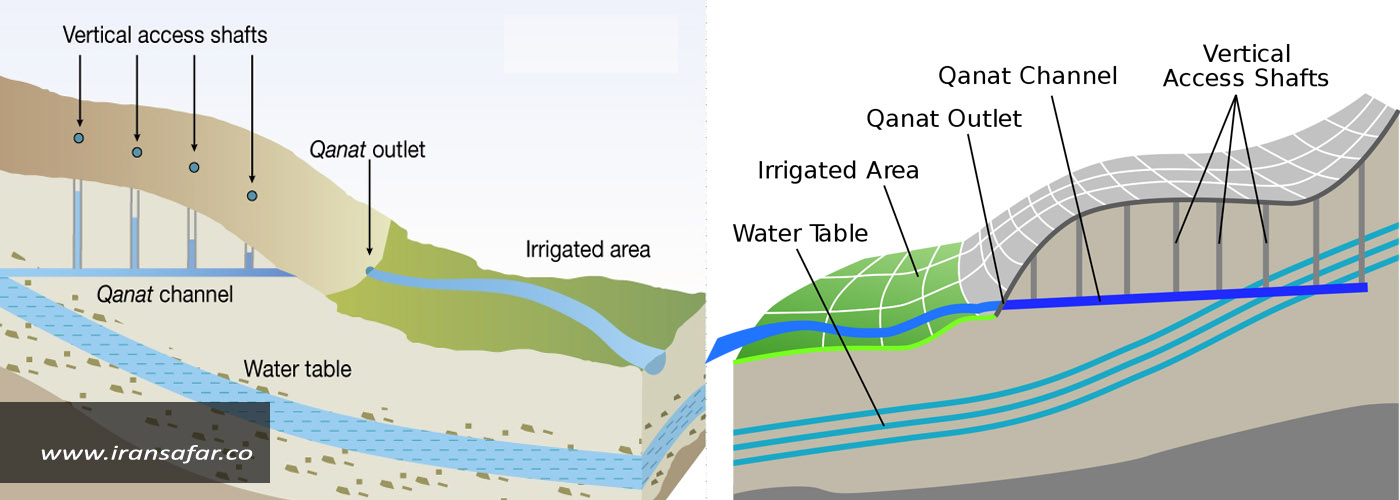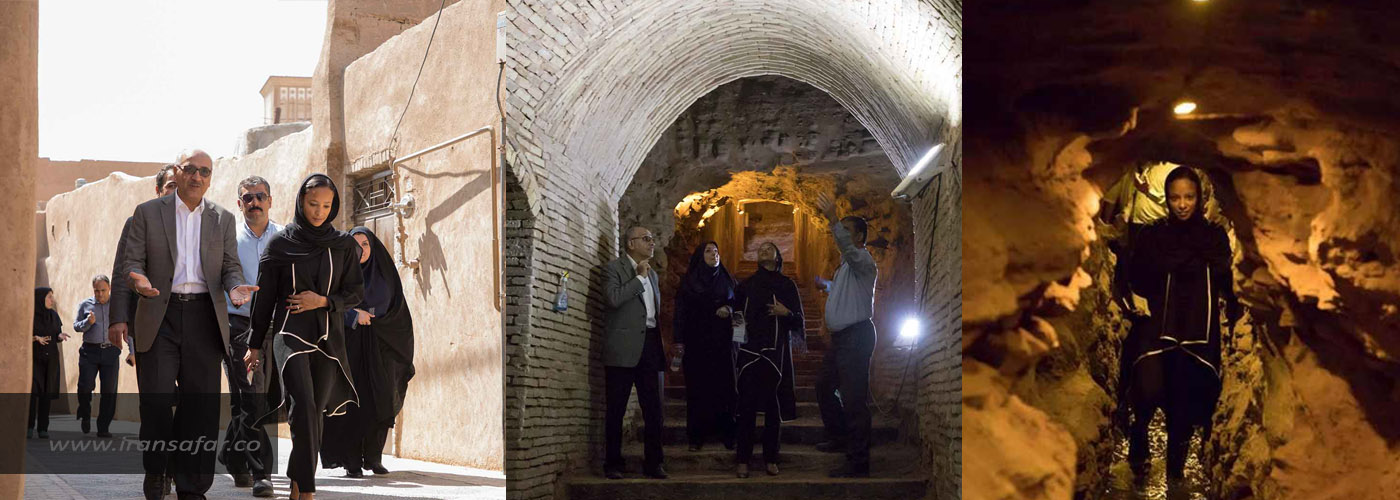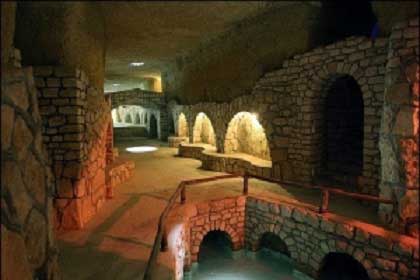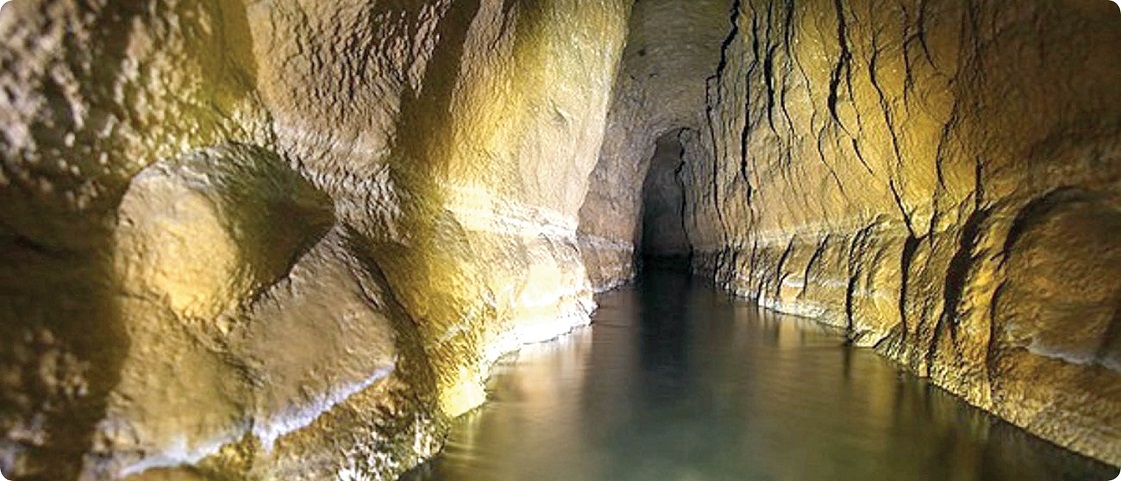Several thousands of years ago, ancient Iranians invented a new system called Qanat or Kariz. With this unique invention it was possible to collect significant amounts of underground water and bring it to the surface, which, like natural springs, reaches its surface throughout the year without any help from inside the earth.
The word Qanat (Ghanat) is Arabic but this aqueduct system has been originally called Kariz in Iran.
Most central Iran is warm and dry. Living in these areas without sufficient rain and running water is impossible, but Iranians have used the Qanat techniques to meet their water needs and fertilize dry deserts. Warm and dry regions of the rest of the world, such as Australia, are uninhabited, but thanks to this achievement, many cities and villages exist at the heart of deserts and their agricultural products including fruits, vegetables and oilseeds are exported.
According to Ministry of Energy statistics, about 36300 Qanats have been identified in Iran. These aqueducts are also found in countries that have been part of Iran or had cultural ties with Persia. In Mesopotamia, especially Iraq and Syria, Pakistan and Afghanistan, western China, southern Russia, young Persian Gulf states, North Africa and southern Europe, but the number of Qanats within Iran alone exceeds the total number of aqueducts outside Iran.
The oldest Qanats of Iran
In 2014, traces of an old Qanat which dates back to the third millennium BC were found near the Seimareh Dam (West Iran). It shows that this system was wide spread around the country and not only applied in the desert. Sargon I, Assyrian ruler mentioned an aqueduct in his attack on Lake Urmia in the early seventh century BC.
In 2003, after the Bam earthquake, an aqueduct was discovered that is more than 2000 years old and was dug in the late Achaemenid period.
Qanats of Gonabad
Qanats of Gonabad are ranked among the oldest in Iran. The still active QASABA qanat in Gonabad town dates from Achaemenid period, 6th to 4th C BC, when Qanat system became very common, and this was probably one of the Achaemenid victorious achievements against the Medes because they could use Qanats to develop more agricultural lands and thus more population. Herodotus also referred to their agricultural activities as a reason of Achaemenid rise.
Silakes, The military commander of Darius I, who conquered Egypt, completed the construction of an aqueduct in Egypt in 518 BC. Later Egyptian and Syrian aqueducts were built in the Roman era.

Qanat System Definition
It’s good to know that the Achaemenids’ knowledge of digging was also applied in their attacks on cities with defensive walls. The Achaemenids used tunnels beneath the walls to gain access to the city or castle. These types of military tunnels have been documented in some conquests in Turkey and Cyprus.
Ghanats should be maintained regularly every year. Each spring, experts go inside the qanats to spot and solve its problems … This is why Persian Qanats have survived over two thousand years and some are still in use. However, the famous Roman aqueducts have all become archaeological sites.
Greek Polybius describes a Qanat in a Persian desert in the second century BC, saying that Iranians were mysteriously bringing water from depth of earth to the surface. Vitrovius (80 BC) describes the Qanat in a book and reveals some of the technical secrets of this engineering phenomenon. At the request of Abdullah ibn Taher Khorasani, a group of writers wrote” Qouni” book in the 8th century AD describing the construction of the Qanat
The first step is to identify the water upstream, usually at the foot of the mountain and at the beginning of the plain. The location of this underground water table is conjectured by Qanat experts then they test it by drilling test wells to make sure it is stable. Then the diggers begin digging the aqueduct well. The mother well is usually one meter in diameter. If the diggers are lucky, they will reach water in depth of less than 16 meters, but may sometimes go much deeper.
Drilling should be done in the fall, which is a dry season, allowing the well to be dug deeper.
The next step after determining the location of the mother well is to calculate the route and slope of the underground channel based on the Qanat outlet location. The slope of the Qnant is usually gentle. If the slope is too low, water will stagnate, and if the slope is high, water will cause erosion and qanat would collapse.
Persian Qanats listed in UNESCO world heritage list
At its 40th meeting in Istanbul, Turkey on July 10, 2016, the World Heritage Committee listed four new sites from China, India, Iran and Micronesia on the World Heritage List. Eleven Iranian Qanats were listed as the 20th in the list of Iran’s UNESCO World Heritage Sites. At the World Heritage Committee meeting, representatives of various countries commented on Qanat case presented by Iran and most countries including Kazakhstan Azerbaijan and Poland supported this Iranaian ancient architectural phenomenon to be registered in UNESCO World Heritage List. Most member states acknowledged the historical importance of Iran’s aqueducts, their sophisticated and civilized systems, and their environmental benefits.
The names of the registered Qanats are: Qassabah (in Gonabad), Baladeh (in Ferdows), Zarch (in Hassan Abad), Mirza Nasrollah Water Mill (in Mehriz), Juppar (in Kerman), Akbarabad and Qasemabad (in Bam), Moon (in Ardestan), Wezwan and Mazdabad (in Isfahan) and Ibrahim Abad (in Arak)
 UNESCO expert visiting Iranian Qanats of Yazd, 2016
UNESCO expert visiting Iranian Qanats of Yazd, 2016




Comment (0)